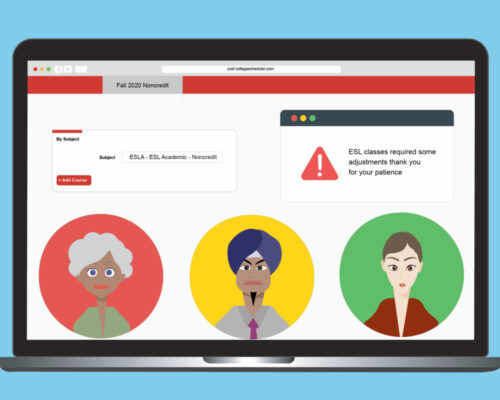Non-credit classes attempt to bridge the digital divide
By Eleni Balakrishnan
ebalakri@mail.ccsf.edu
Non-credit classes at City College fully transitioned to online registration and remote learning this semester, and despite many obstacles ahead, students and faculty hope some of the changes are here to stay.
City College offers non-credit course options in English as a second language, child development, and computer applications, as well as courses for older adults and disabled students. These courses allow people to gain valuable life and work skills, for free.
“We’re one of the largest non-credit programs in the state and we’re for sure the college that has the largest percentages of its offerings in non-credit,” said English as a Second Language (ESL) Department Chair Greg Keech.

Keech said non-credit ESL classes make up 18 to 20% of City College’s revenue, with 15,000 students last year, but his department’s biggest challenges with remote learning include just supporting students with accessing class online.
Debora Nicole Bolanos Larios, 25, is taking Vocational ESL and Keyboarding this semester, but also spends time helping fellow non-credit students move online.
“Most of the students don’t know how to use their phones, how to join the classes from Canvas … so I have been helping them step by step,” Larios said. She helps students with anything from downloading apps onto their phones to signing up for their student ID number.
Larios said non-credit students have had to adjust to the waiting periods of online registration: the 48 hours after signing up for a student ID number, then the 24 hours before gaining access to Canvas.
Historically, non-credit students could visit campus to register for classes and were given a piece of paper telling them where class would be held. They typically had limited online interactions with teachers or classmates, if any.
After the sudden move to remote learning in March, teachers scrambled to find their students’ email addresses, but many never made contact. By the end of the spring semester, Keech began community outreach along with other instructors and students through flyers, social media and local radio stations.
Despite enrollment hurdles, Larios emphasized how helpful applications like Canvas have been for assignment tracking, communication with teachers and classmates, and flexible access.
“The first week or two of classes, it was like hitting a brick wall for teachers,” Keech said. But now, he’s hearing a lot of positive feedback from students and teachers alike. “There’s a lot of things about face to face that we’d like better, but there’s some things about remote learning that we’ve come to appreciate.”
For example, Larios said students who wouldn’t otherwise take classes due to work or childcare schedules, now have the opportunity to.
Some of the successes of online learning have been so evident that Keech expects his department will make some of the changes permanent, even after classes eventually return to in-person learning.
Until then, Keech is working to make City College’s non-credit courses “more multilingual at the front end,” as part of his goal to get more students enrolled. He is currently looking for volunteers to help ESL students of various languages find courses, register for classes online, and use Canvas.
“I think that if we do this with non-credit students — this goes for all students — but if we make sure that they understand how to access this technology, we’re helping them bridge the digital divide, and we know that’s a big divide in this country,” Keech said.
In spite of its importance, non-credit course enrollment has been declining for years, and this semester was a close call, Keech said.
“We’re actually doing okay in credit; we’re pretty much where we were before, and non-credit is doing better than we thought,” Keech said. “Now, I wouldn’t say close to its normal numbers. [But] it’s not horrible. It’s not as bad as I was afraid of.”
In addition to the pandemic, Keech believes many factors have been bringing down enrollment in the non-credit ESL courses he oversees: the changing demographics of San Francisco and increasing cost of living, the current political climate of anti-immigration, and decreasing numbers of high school students.
Keech also feels these courses are not valued or supported by the school’s administration. While many see non-credit courses as a way to prepare for credit courses or traditional university schooling, he said the majority of ESL students do not have that goal.
“From my point of view, the college is worried too much about what it can count [for] credit, and not worried enough about who we’re serving and what success means to them,” he said.
